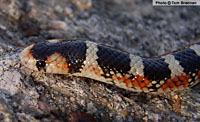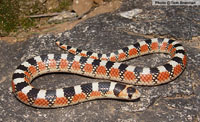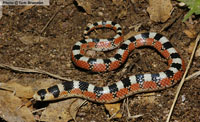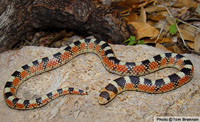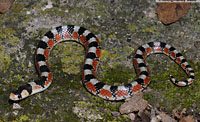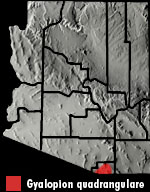Online Field Guide to The Reptiles and Amphibians of Arizona


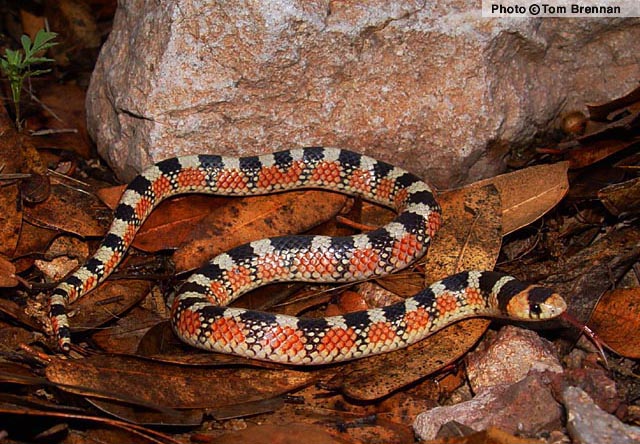
Santa Cruz County, AZ
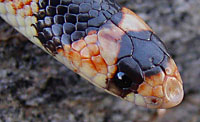 Santa Cruz Co., AZ |
||
| THORNSCRUB HOOK-NOSED SNAKE Gyalopion quadrangulare |
Non-Venomous
|
| DESCRIPTION: A small (up to 300 mm or 12″ in total length) relatively stocky snake with a bold pattern of black saddles on a light cream to off-white background. Black saddles interrupt a wide, red to orange stripe on each side of the body. The black saddles are solid and rectangular on the dorsal surface and taper to a point on the lower sides. White spots mark the black saddles on the tapered lateral aspects. A black mask crosses the top of the head and covers the eyes. The ventral surface is pale cream. The pupils are round and the scales are smooth and shiny. The scale on the snout (rostral) is concave on top and noticeably upturned along the leading edge. The subcaudal scales are bifid (divided), distinguishing this snake from the Long-nosed Snake.
DISTRIBUTION: This snake only enters Arizona in a small portion of Santa Cruz County near the border with Mexico. In our state it is found at elevations between 3,500′ and 5,500′. HABITAT: In Arizona this snake inhabits rolling mesquite-covered hills and oak-lined drainages within the Madrean Evergreen Woodland and Semidesert Grassland communities. It is usually encountered in areas with gravelly soil. DIET: It presumably uses its “hooked” snout to root through surface debris and under rocks and logs for prey which consists of scorpions, spiders, and a variety of insects. REPRODUCTION: Reproductive behavior is poorly known. It lays clutches of up to 6 eggs. Babb, R.D., G.L. Bradley, T.C. Brennan, A.T. Holycross. 2005. A preliminary assessment of the diet of Gyalopion quadrangulare. (Serpentes: Colubridae). Southwestern Naturalist 50(3). Bartlett. 2000. Snakes of North America: Western Region. Gulf Publishing Co. Houston, TX Brennan, T. C., and A. T. Holycross. 2006. A Field Guide to Amphibians and Reptiles in Arizona. Arizona Game and Fish Department. Phoenix, AZ Fowlie. 1965. The Snakes of Arizona. Azul Quinta Press, Fallbrook, California Stebbins. 1985. Western Reptiles and Amphibians. Houghton Mifflin. New York, NY |
|
Visit Partners in Amphibian and Reptile Conservation:


HOME
Copyright © 2023, Arizona Game and Fish Department. All rights reserved.
If you make use of the textual contents of this site in reports, publications, etc. please cite and credit the author(s) and photographer(s). All photos on this website are copyrighted. However, those found in the species account section may be used for any noncommercial scientific, educational, or conservation purposes provided that photographs are not altered and continue to bear the copyright symbol and name of the photographer. Please contact the photographer regarding commercial use of copyrighted photographs.










